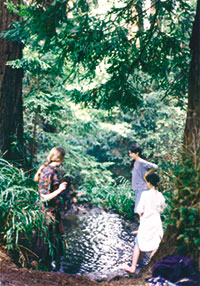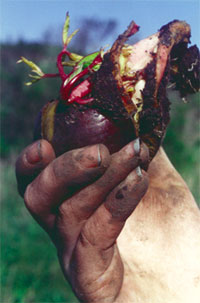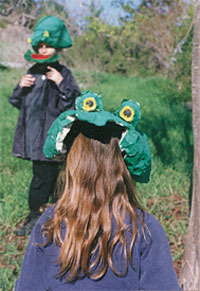The Use of Performance Art for Environmental Restoration
These are excerpts from the Introduction:
"If indeed the environmental crisis is a crisis of perception, work in the arts can present us a vision, a new perception and a new impulse to help guide us into the future." — Jim Nollman
We need the insight of the artist in everyone to move the world forward as much as we need the facts of the scientist. The work in this guide is about combining; seeing the interplay within natural history, science and art through the poetic, metaphoric and ancient voices of our natural heritage.
This book is a guide for educators, parents, artists and concerned community members who wish to help heal the natural world and develop awareness through performance art. The content of the performances described in this guide combine and blend the arts and sciences. Every month there is a focused theme worked on through writing, visual arts, research, playwriting and a restoration project at a site we have chosen together. Each performance piece is nine months of work—a school year. The people involved in this work are parents, teachers, and students in independent study and homeschooling.
Homeschooling is easily moveable, making the community its classroom. The learning process takes place out in the world, in the home and a in variety of group settings. The stories that bring us to life as performers are developed from our awareness of the ecological life of our community and how we can best serve its needs.
The themes chosen for a performance have a strong resonance for the students and are wide enough for us to inhabit with an imaginative heart. The process involves in-depth dialogues and shared experiences about the theme. This work leads us further into creating our own poems, stories, images and songs which gradually shapes a story for a performance. The final performance is for the public, taking place in a location in nature that needs attention or healing; a large pond, a wetland area, an open field or a section of our river. The performances shared in this guide, Calling the Frogs Back, One of the Bird's Feathers, The Unseen River and Second Nature, evolved one after the other much like the game of leap frog.
A first step into a theme may be just the story of a tiny frog, but before long that frog becomes our guide to the heart of the wilderness. Everything in the wilderness is in a vital, interwoven relationship. The same quality of interrelatedness is at the center of our work. There are exercises in this guide to help lead the reader into the exploration of a theme. Each section also includes selected poems and stories that were part of the final performances.
The content and style of the material presented here developed out of the uniqueness of our particular group of people and locale. There is no formula for this work. It is dependent upon what is central to your community and based on the vision of your group. It is my hope that by seeing the angles in which we looked at each of these themes you will be brought closer to seeing your own content, scenes and resources more vividly and that your unique vision will bring through new ways to care for the natural world.








